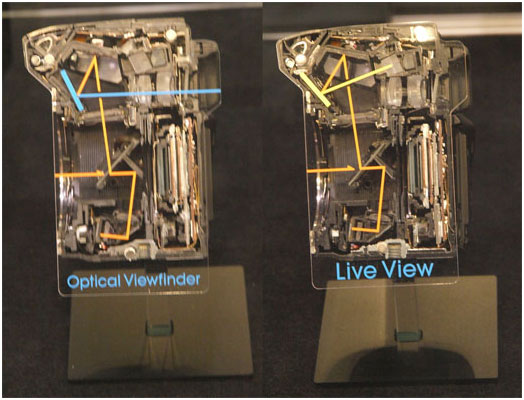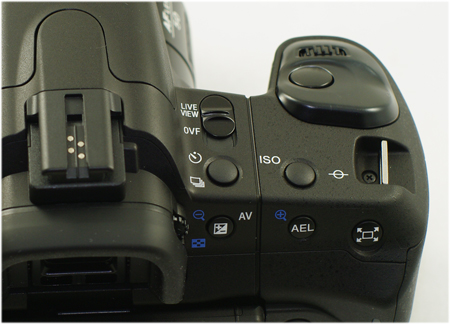Sony A350: Full-Time Live View at 14.2MP
by Wesley Fink on April 3, 2008 3:00 AM EST- Posted in
- Digital Camera
Live View and the Optical Viewfinder
Sony Live View impressed us at PMA, and now that we've spent more time with a production A350 we are even more impressed with the Sony version. Sony Live View is definitely unique compared to others, and their description as Quick AF Live View is justified.
Everyone else now uses the imaging sensor to provide Live View, and while that method works and is fairly cheap to implement, it does have serious limitations. First, it eats precious power, as the mirror has to be flipped up and held out of the image path during Live View. Second, the camera must flip down the mirror for focus and metering, which slows down shooting and momentarily turns off Live View. This makes Live View more a check-box feature on today's digital SLRs than something truly like the Live View seen on Point-and-Shoot cameras. Some variations of this exist, such as the Canon Live View system with contrast-detection focusing that has been announced for the Canon XSi, but all the Live View systems have been slower and less capable than optical AF.

In the A300 and A350, Sony introduces a totally different Live View System, based on an additional live view sensor and a tilting pentamirror. In the Sony Quick AF Live View, the pentamirror tilts and the optical viewfinder closes during live view. It can also run continuously without overheating the sensor, which is an early reported problem with the Canon system.

One huge improvement from the prototypes we saw at PMA is the top mounted switch for Live View or the Optical Viewfinder. It is a mechanical switch that works with or without camera power, and it is exceptionally easy to slide without the excessive resistance we saw on the PMA cameras. When the switch is in Live View, the viewfinder blind closes so there is no mistaking the camera mode.
In our shooting with a production A350, the Quick AF Live View seemed just as fast as the optical viewfinder. Sony specifies a slight speed penalty with Live View, however, with continuous shooting of 2FPS in Live View and 2.5FPS with the Optical Viewfinder. If you look closely at the specs on page two you will see this is slower than the 10.2MP models (A200 and A300) which manage 3FPS with less info to write with the lower-resolution sensor.
Those who are used to the Live View capabilities of their point-and-shoot digitals will love the new Sony A350 and A300. They will seem very familiar and Live View is exceptionally easy to select and use. The bad news is that the 2.7" Live View LCD only shows 90% of the image you will capture. That won't matter for the snapshots LV will mainly be used for, but it is an obvious problem if you are using Live View for high or low-angle Macro shots with the tilting Live View Screen. When you process or review the captured images, there is a lot more around the image than you framed on the Live View screen. Keep that in mind during critical shooting and it will be less of a problem.
Optical Viewfinder
It's a good thing the Live view is useful and fast because the optical viewfinder is absolutely horrible - both dim and tiny with a pronounced "looking down a tunnel" effect. You can see why this is the case with a close look at the viewfinder specs on page two. The top A700 has a good viewfinder with a .90x magnification, and it uses a true pentaprism for a bright clear image.
The 2006 A100 had a decent .83X pentamirror viewfinder that was both larger and brighter than normally seen on cropped sensor DSLR cameras. That viewfinder appears to be carried over intact to the new A200. Then there is the new A350/A300 with a .74X optical viewfinder. The view is reasonably bright - for a light at the end of a tunnel - but the tunnel is so long you are left with the impression that the viewfinder is dim. The screen itself appears tiny and the usefulness of the optical viewfinder is seriously reduced in the A350 and its sister A300.
If you will mainly shoot with the optical viewfinder and don't really care about the tiltable LCD and Live View, then go with the A200 as the viewfinder is much better. The fly in the ointment comes if you want the 14.2MP sensor because the other options are 10MP - and that gives the A350 about 40% higher resolution than the other entry-level Sony cameras.
It's a good thing the A350 has good full-time Live View because we would flunk the camera if we had just the optical viewfinder to depend on. Even the tunnel-like Olympus E-510/410 viewfinders are better than the new A350 - and they are hampered by the smaller sensor with the 2X multiplier. There are ways to get around most viewfinder issues as Olympus showed us with the superb viewfinder in the new E-3, where the small sensor is assisted with a high pentaprism with a 1.15X magnification. The A350 optical viewfinder is usable, but in general it is pretty awful. Sony really needs to improve this viewfinder because it will matter to most users who don't mainly use Live View, and many will be buying this camera for the 14.2MP sensor and not just the Live View.










113 Comments
View All Comments
dug777 - Monday, March 31, 2008 - link
I would also simply suggest using a time-delay shot if you don't have a wireless or wired shutter release :)dug777 - Monday, March 31, 2008 - link
That or they're out of focus?Heidfirst - Monday, March 31, 2008 - link
Interesting review as usual with a more general consumer orientated view as compared to some of the more "specialist" DSLR sites, thank you.A vies notes, if I may:
"For those who wish to buy the body alone, only the A350 ($799) and A700 ($1399) are available without a kit lens"
I realise that Anandtech is USA-centric but also does get significant traffic from other countries - this varies from country to country according to local Sony marketing decisions e.g. if I want to buy an A200 body only in the UK that's not a problem.
Often the street (as opposed to msrp) prices for the basic kit 18-70mm package are so little more than body only though that you may as well get the 18-70 too.
"The layout and pattern is the same as the A200, A300, and earlier A100 suggesting it is the same AF module. The AF speeds on all models also support the conclusion that this is likely the same venerable AF module used in previous Minolta and Sony digital SLRs. "
Sony claim 1.7x faster focussing (probably largely as a result of using a more powerful motor but also a tweaked system).
Probably little has changed because the basic Minolta metering & AF system going back 20 years or so has been a very good base & only required minimal tweaks/upgrades.
Re. the battery:
If you compare Sony NP-FM500H prices it's similar to those for the official Canon, Nikon, Pentax etc. batteries so the issue isn't really the pricing of the official batteries but the unavailability of generic copies.
When I bought my A700 I also bought a spare battery but I've never actually had to use it as battery life has been very good. Extensive Live View use on an A300/A350 may use more I would imagine though.
At least Sony now have a standard battery throughout their DSLR range whereas on Canon & Nikon as you upgrade bodies you change batteries so you can't carry them over but must buy new.